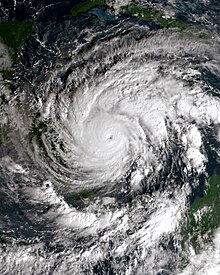
Back Huracà Iota Catalan Huracán Iota Spanish Hurrikaani Iota Finnish Ouragan Iota French Uragano Iota Italian Iota (orkaan) Dutch Furacão Iota Portuguese Йота (ураган) Russian Hurricane Iota SIMPLE พายุเฮอริเคนไอโอตา Thai
 Iota at peak intensity approaching Nicaragua on November 16 | |
| Meteorological history | |
|---|---|
| Formed | November 13, 2020 |
| Dissipated | November 18, 2020 |
| Category 4 major hurricane | |
| 1-minute sustained (SSHWS/NWS) | |
| Highest winds | 155 mph (250 km/h) |
| Lowest pressure | 917 mbar (hPa); 27.08 inHg |
| Overall effects | |
| Fatalities | 84 total |
| Missing | 41 |
| Damage | $1.4 billion (2020 USD) |
| Areas affected |
|
| IBTrACS | |
Part of the 2020 Atlantic hurricane season | |
Hurricane Iota was a devastating late-season Category 4 Atlantic hurricane which caused severe damage to areas of Central America already devastated by Hurricane Eta just less than two weeks prior. The 31st and final tropical cyclone, 30th named storm, 14th hurricane, and record-tying seventh major hurricane of the record-breaking 2020 Atlantic hurricane season, Iota originated as a tropical wave that moved into the Eastern Caribbean on November 10. Over the next few days, the wave began to become better organized and by November 13, it developed into a tropical depression north of Colombia. The depression strengthened into Tropical Storm Iota six hours later. The storm was initially impacted by some wind shear, but a center relocation and relaxed shear allowed Iota to quickly strengthen into a hurricane on November 15, after which it underwent explosive intensification, peaking as a high-end Category 4 storm, with wind speeds of 155 mph (249 km/h). After weakening slightly, Iota made landfall in northeastern Nicaragua as a mid-range Category 4 hurricane, becoming the strongest recorded hurricane to make landfall in Nicaragua in November. Iota then rapidly weakened as it moved inland, dissipating on November 18.
Iota's precursor disturbance generated flash flooding on several Caribbean islands. Tropical cyclone watches and warnings were first issued on November 14 in parts of Colombia, Nicaragua, and Honduras, with the latter two countries still recovering from Eta. Heavy rains associated with a tropical wave and Iota brought heavy rainfall to parts of Colombia, leading to flash flooding and mudslides. Extremely heavy rain fell on much of Nicaragua, widening flash flooding caused by the hurricane's high storm surge. Mudslides caused extensive damage and multiple deaths. At least 67 people were killed due to Iota, including at least 28 in Nicaragua and 16 in Honduras, among other countries.[1][2][3][4] As many as 41 people were reported as missing. The preliminary estimate for the damage in Nicaragua was $564 million (2020 USD).[5] Total damage estimates for the hurricane were set at $1.4 billion (2020 USD).[6]
Relief efforts soon followed, which included placing tents, opening temporary hospitals, and delivering food and water to those in need. Numerous power outages were restored in the days that followed. Donations worth hundreds of millions of USD were given to affected countries. An estimated total of 5.2 million people were affected by the storm.[7]
- ^ Digital, Por Edición (November 18, 2020). "EN VIVO | Iota deja al menos 16 muertos en Nicaragua, según fuentes oficiales". La Prensa (in Spanish). Retrieved November 18, 2020.
- ^ Cite error: The named reference
Honduras16was invoked but never defined (see the help page). - ^ Andrea Sosa Cabrios (November 19, 2020). "Death toll from storm Iota rises past 45 in Central, South America". bakersfield.com. Retrieved November 19, 2020.[permanent dead link]
- ^ "Monitoreo Azul y Blanco reporta 28 muertos por el huracán Iota en Nicaragua". Confidencial (in Spanish). November 21, 2020. Retrieved November 23, 2020.
- ^ Cite error: The named reference
:4was invoked but never defined (see the help page). - ^ "Global Catastrophe Recap November 2020" (PDF). Aon. December 10, 2020. Retrieved December 10, 2020.
- ^ Situation Report (November 20, 2020). "Latin America & The Caribbean: 2020 Hurricane Season Situation Report No. 4". reliefweb.int. Retrieved November 21, 2020.